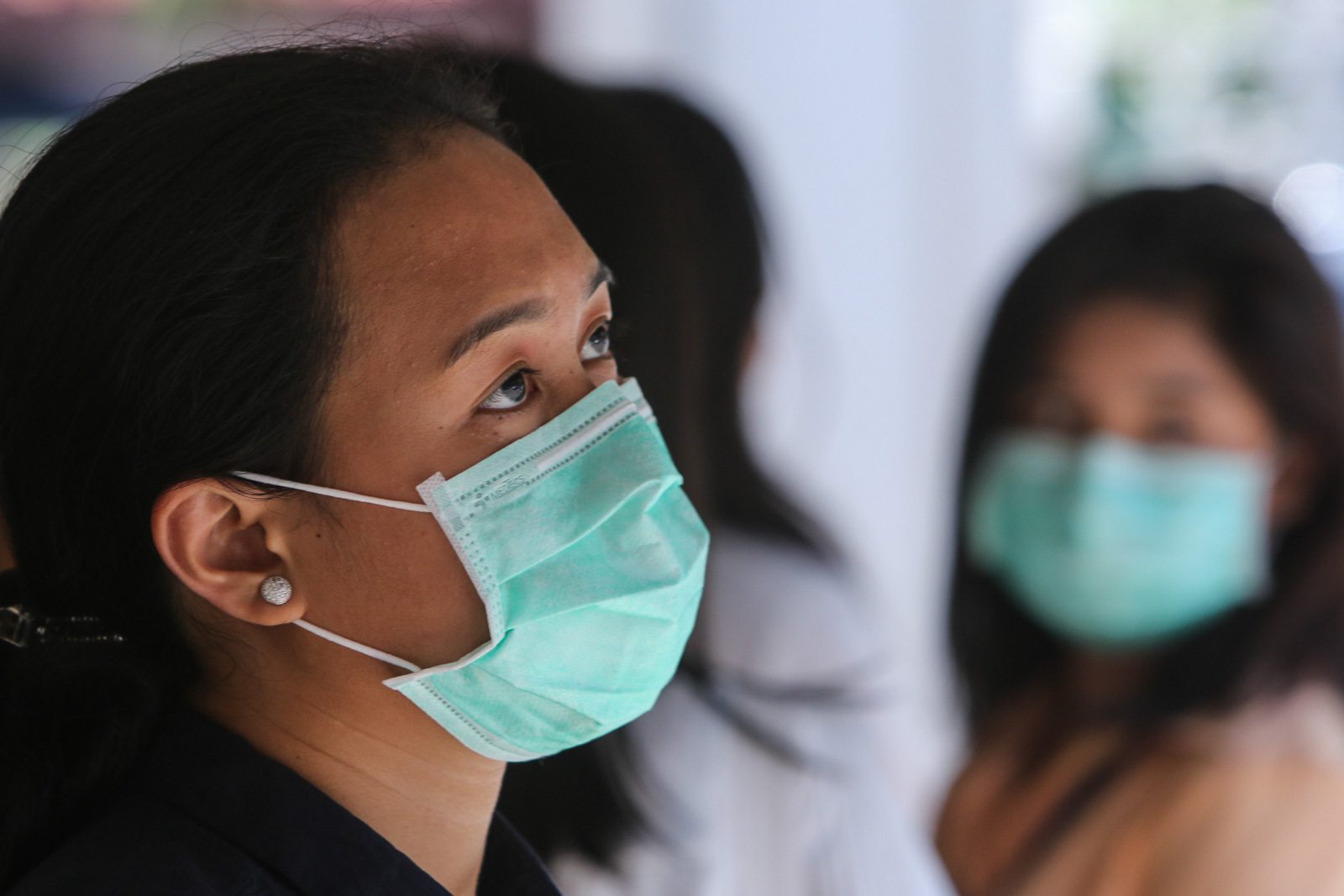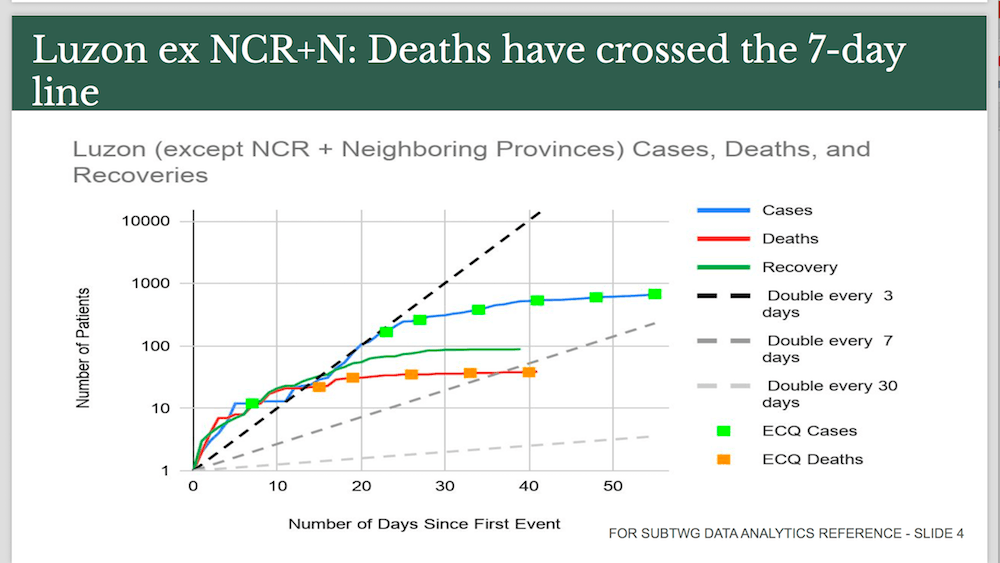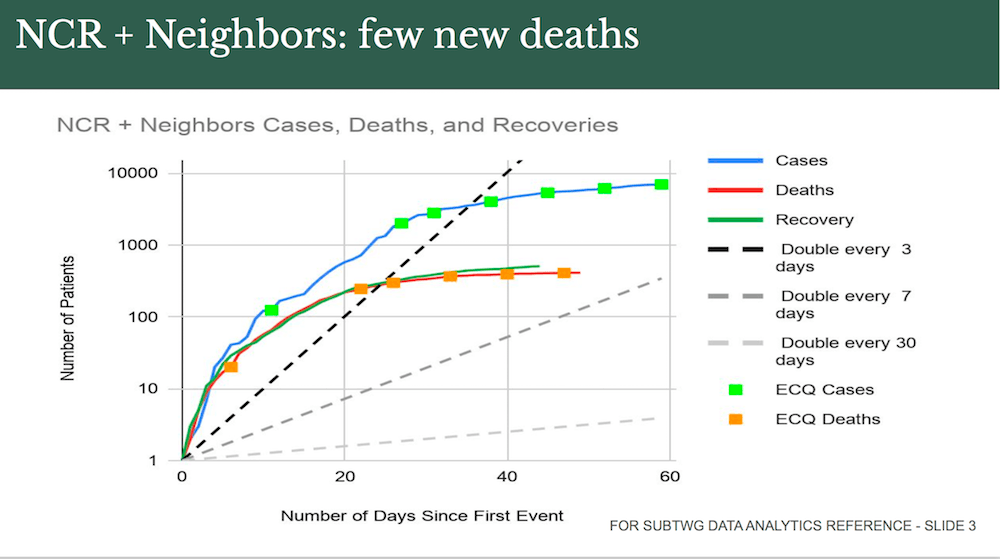SUMMARY
This is AI generated summarization, which may have errors. For context, always refer to the full article.

MANILA, Philippines – An epidemiologist from the Ateneo School of Medicine and Public Health on Tuesday, May 5, said that the coronavirus curve in the Philippines has started flattening.
“The data you’re seeing now is about 10 or as much as 14 days behind. If there has been no significant changes, we would expect the flattening to continue, ” Dr John Wong said.
Despite backlog, Wong said that the flattening of the curve is “a real event.”

Wong, however, noted that the data he presented to reporters was the picture of the pandemic in the country 10 to 14 days ago.
According to Wong, the doubling time – the time it takes for the total number of coronavirus cases to double – for both the number of cases and number of deaths has already flattened, “meaning we’re getting fewer and fewer of these cases as time passes by.”


Pressed how many cases the country would have during a peak, Wong said, “Difficult to predict how many cases we will have at the peak.”
Wong is working with the Department of Health (DOH) and the government task force on coronavirus data and analytics sub working group.
Bigger picture
Meanwhile, DOH Undersecretary Maria Rosario Vergeire reminded the public that the data should be interpreted in the bigger context of the situation, taking into account the healthcare capacity of the country and the limitations of the government.
“Dapat hindi ito intindihin sa iisang konteksto lamang. Hindi lang numero ng kaso ang pinag-uusapan dito. Pinag uusapan din natin ang kapasidad ng ating health system kung tayo ay makaka-agapay kung saka-sakaling dumami ang kaso,” Vergeire said.
(We should not interpret this within only one context. The number of cases is not the only issue here. We are also considering the capacity of our healthcare system in the event the cases blow up.)
Vergeire also said that the data is affected by backlogs in COVID-19 testing and data encoding.
“We’re trying to network these backlogs among existing labs so we can reduce them. With the additional labs, we would have no backlogs in time,” Vergeire said in a mix of English and Filipino.
In a report published by the UP COVID-19 Pandemic Response Team on April 20, over 50,000 people may require hospitalization at the peak of the coronavirus pandemic in the country, a number that would overwhelm the local health care system.
They said that based on their outbreak peak scenario – that one COVID-19 patient infects two people – “our simulations show that about 51,933 Filipinos will need hospitalization, approximately 13,194 of whom will need ICU treatment.”
They estimated that outside Metro Manila, the biggest bulk of severe and critical patients would come from Central Luzon, CALABARZON, Western Visayas, and Central Visayas. (READ: Lockdown lessened rate of coronavirus infections in PH – U.P. experts)
Meanwhile, former DOH chiefs, in their 4-point policy plan, have recommended to the government to expand mass testing capacity so more infections from the population could be detected. (READ: Former health chiefs, experts propose policy for dealing with COVID-19)
At present, the government “massive testing” only covers severe to critical cases, and the vulnerable population.
On May 4, Monday, Vergeire said that the government planned to put up 4 mega swabbing centers in Metro Manila and Bulacan to increase the country’s coronavirus testing capacity.
Once operational, Vergeire said 5,000 tests can be conducted daily.
The DOH had earlier aimed to conduct some 8,000 tests daily, but by the end of April, it had only been able to conduct a little over half of its target – around 4,900 – as of April 28.
COVID-19 vaccine needed
Wong also warned that cases can also rise as long as there is still no vaccine for COVID-19. (READ: The latest in the global race for a coronavirus vaccine)
“Until we have a vaccine, we should see surges, up and down movements of the epidemic curve. Although we see some flattening of movement or improvement now, if and when we relax the ECQ, we should be vigilant about resurgence,” Wong said.
He explained that the pandemic will only end when a vaccine is discovered.
According to the DOH, vaccines for the coronavirus being developed by other countries would take about 6 to 12 months or even 1 and 1/2 years to be ready for commercial use.
Vergeire said that the coronavirus pandemic in the country might last until January 2021 if no intervention is done. (READ: Worst case scenario? Pandemic may last until 2021 if no intervention – DOH)
Meanwhile, Wong said it will be up to the government task force to decide whether and when the lockdown will be lifted in parts of the country.
Metro Manila and other parts of the country remain on lockdown until May 15. – Rappler.com
Add a comment
How does this make you feel?
There are no comments yet. Add your comment to start the conversation.